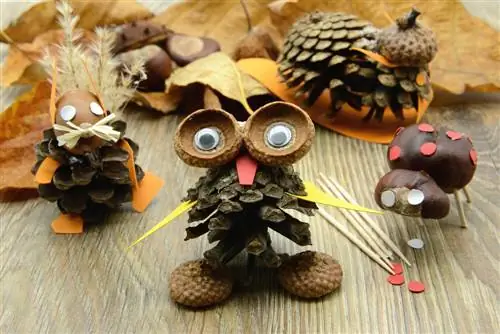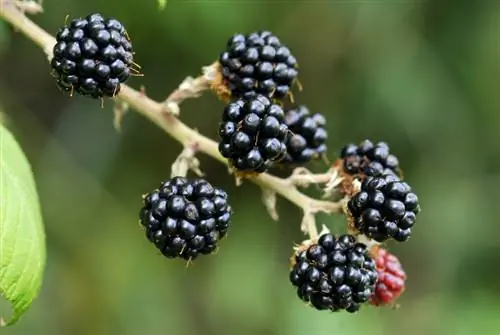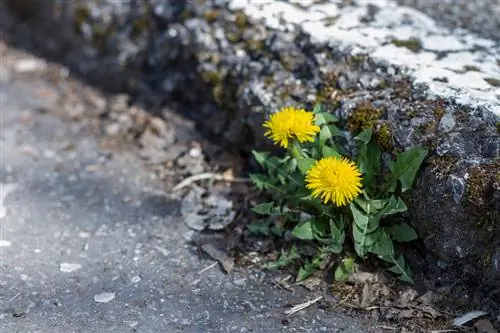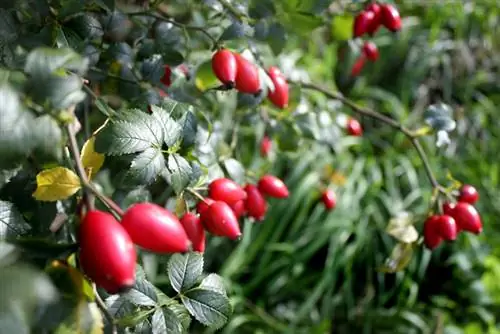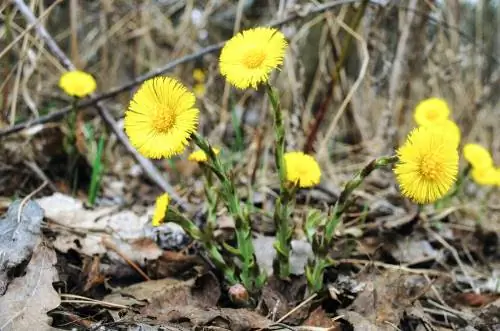- Author admin [email protected].
- Public 2023-12-26 14:17.
- Last modified 2025-06-01 06:02.
Tinecones At first glance you can't see the diverse talents hidden behind them. We invite you to take a stroll through the fascinating world of woody-brown natural treasures from the coniferous forest. Interesting information about identifying features, types of cones, how to collect them at the best time and imaginative uses are waiting to be explored by you.
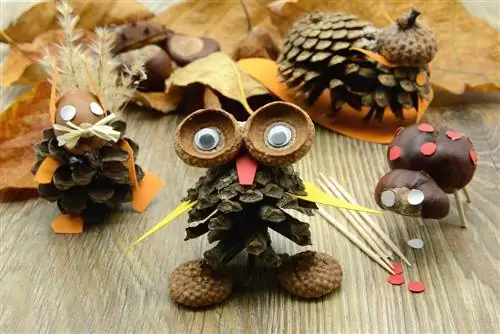
Can you collect pine cones?
If you collect pine cones, you can use them to craft and decorate at home. The cones stand vertically on the branch and only fall down when they are ripe. Pine cones make suitable bird food and fuel.
- Pine cones stand vertically on the branch where they decay and release winged seeds.
- Intact cones on the forest floor are not pine cones, but come from spruce, pine, larch or Douglas fir.
- With pine cones you can do crafts, decorate, grow new fir trees, make bird seed cones, fuel and jam.
Pine cones - interesting and amazing facts
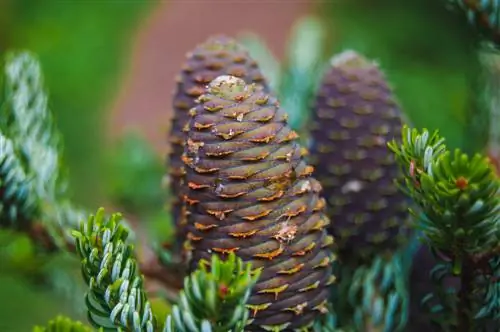
Real pine cones stand upright on the branches
Pine cones are female, spike-shaped inflorescences whose scale-like bracts form spirally around an axis and slowly become woody. The male counterpart is smaller, does not become woody and falls off after flowering, so it is not a pine cone in the traditional sense. Even this short explanation of terms makes you sit up and take notice and awakens your curiosity for further information about a true treasure of nature. We invite you to follow the journey of a pine cone through the seasons:
- Late winter: male flower buds on the bottom of the shoot, female flower buds on the top of the shoot
- Spring: at the age of 30, the fir tree unfolds its flowers for the first time
- Flowering period: April to June with yellowish, 2-2.5 cm male flowers, cylindrical, not woody
- Pollination: Transfer of male pollen to female, upright pine cones by the wind
- Wilt: in summer, wilting of the male flowers, which wither and decay on the branch
- Cone maturity: from May/June female pine cones, 10-16 cm long, woody with scales and winged seeds
- Sowing: from September onwards, the removal of woody scales, the expulsion of seeds, the disintegration of the cones on the tree
This CV of pine cones makes no claim to scientific completeness. Rather, the short version takes a look at the fascinating process from the bud to the mature, female pine cone, which literally tears itself apart so that the winged offspring can find its way to the forest floor. The sad remnant on the tree is a woody cone spindle, which usually only falls off the fir branch after a few years.
Collecting pine cones - tip for the season
The above history of pine cones reveals that you cannot collect intact pine cones from the forest floor. What covers the ground in autumn are mostly the cones of pine, spruce and other native conifers. To collect authentic, undamaged pine cones, you don't have to bend your knees, but rather stretch hard. Starting in late August or early September, look for upright, greenish-brown pine cones in the forest on the tops of coniferous branches. Ideally you have a pair of bypass scissors with you to cut off a nice tenon.
Using pine cones - collection of ideas
The interest of children and young people should not be limited to the fact that pine cones are called fir cone in English. In fact, the woody reproductive organs of conifers surprise with a colorful variety of creative, natural and useful uses for every age group. Let these ideas inspire you for an appropriate answer to the question: What can you do with pine cones?
| Pine cone usage | Idea |
|---|---|
| Crafts | Advent and Christmas decorations |
| Deco | Decorate balcony box |
| Bird food | Cones instead of fat balls |
| Growing fir trees | Harvesting and sowing seeds |
| fuel | Pine cones as chimney starters |
An exotic use of pine cones is practiced in Siberia. In the cold north of Russia, the cones of fir and pine trees are traditionally used to make jam, cone honey, tea and strong throat cleaners.
Crafts with pine cones - ideas

You can make all kinds of crafts from cones
Crafting with pine cones during Advent is great fun for the whole family. When it's stormy and snowing outside, young and old gather around the kitchen table to create their own cone creations in a cozy atmosphere or to create some of the following craft ideas:
- Make an Advent wreath or mini Christmas tree out of cones
- Drill the cone with a Forstner bit to make room for a tea light
- Spray pine cones in color, arrange them on a wooden board with fairy lights, cotton wool and hot glue as a winter landscape
- Glue cones in a circle and use ribbons, beads, balls and similar decorative material to create a door wreath
- Decorate the large cone with acrylic paint, attach the silk ribbon with hot glue and use it as a Christmas tree pendant
- 4-6 Put pine cones together as a star with hot glue, decorate with acorns, dried flowers or beads
Making figures out of pine cones also inspires the smartphone generation for creative work beyond the virtual world. The range of imaginative possibilities extends from animals such as hedgehogs, owls and penguins to fairy tale characters such as Pumuckl and Peter Pan. The following section explains how you can easily make an elf out of pine cones with your children with easy-to-follow step-by-step instructions.
Tip
Collect contaminated cones from the forest floor, remove moss, soil and other coarse dirt with tweezers or a brush. To clean, soak the pine cones in a solution of 2 parts water and 1 part vinegar for 20 minutes. Dry the wet and clean cones on a baking tray in the oven at 90° to 100° Celsius under constant supervision. By drying them in the oven you can open the closed pine cones at the same time.
Make elves out of pine cones - instructions
Making an elf out of pine cones is one of the classics for long autumn and winter evenings when the television, computer and cell phone need a break. The following instructions explain step by step how cones from fir, spruce or pine trees are transformed into funny hanging gnomes, complete with pointed hat and shaggy beard:
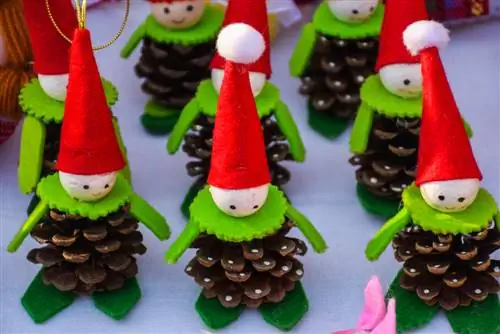
Making cone gnomes is a must in the cold season
Material requirements
- Cones of fir, pine or spruce
- Felt, wine red, dark green, orange, each 95 cm wide, 30 cm long and 0.9 cm thick
- Pompons, light brown, 4-25 mm thick
- Scatter pieces made of felt, e.g. B. colorful autumn leaves
- Plush fabric or imitation fur light gray, 150 cm wide, 30 cm long, 10 mm high
- cord, e.g. B. 1 roll of natural fiber cord, 1.5 mm thick, 80 m long
- Sewing thread, red, green, orange
- Craft scissors
- Sewing needles or large darning needles
- Glue gun and hot glue
- Chenille wire, 14 mm x 50 cm
You will also need a pen and paper to draw a template for the gnome pointed hat.
Step-by-step instructions
Please carefully select the most beautiful, undamaged cones that are destined for a second life as hanging gnomes. There is no hindrance if you use pine cones, pine and spruce cones in different sizes. These instructions can be adapted to any size and number of elves you want.
- Transfer the template of the pointed hat onto the felt with a pen and cut it out
- Adjust hat cut to a tenon, fold and sew or glue together along the two edges
- Push the chenille wire under the hat and create a rustic tip shape
- Cut the plush fabric into rectangles with scissors (e.g. 5 cm x 4 cm)
- cut a small recess in the middle for the nose, bevel the side edges slightly
- Place the cone on the tip and glue the beard to the top edge
- Glue the pompom into the recess as a nose
- Put on the Secret Santa hat so that the top edge of the beard is covered and stick it in place
- Decorate pointed hat with glued felt leaves
Finally, the cone gnomes receive a hanger. Thread the cord into a large sewing needle and pull both through the tip of the pointed hat past the stabilizing chenille wire. Do you still have some pompoms and felt leaves left? Then thread these onto the cord as additional decoration. Now all you have to do is knot the hanging cord and hang the cute elves made of pine cones on the Christmas tree.
Pine cones as balcony decoration - tips & tricks
The first pine cones are ripe just in time for the start of the autumn season. Anyone who wanders through the forest with their eyes open from the end of August can collect the cones from the branches before they dissolve into their individual parts. The cones of spruce, pine, Douglas fir and larch lie on the forest floor ready to be picked up, at the latest after the first autumn storms. Regardless of which conifer the cones come from, they can be used perfectly for creative decoration ideas on the autumn balcony. The following variations may inspire your imagination:
- Attach pine cones and fairy lights to branches of the corkscrew willow and arrange in a deep, frost-proof pot
- Fill terracotta flower pots with coconut soil, insert large pine cones and surround them with moss
- Plant hardy flower boxes, creatively arrange pine cones, gnomes, colorful balls, fairy lights
- Cover balcony table with jute sack, fir greenery, pine cones and lantern, spray thickly with artificial snow
In autumn, empty baskets, glass vases and glass bowls are just waiting for you to return home from the forest with a bulging bag. In combination with fairy lights, Christmas balls and coniferous branches you can conjure up a romantic decoration for the Advent and Christmas season. If you use LED fairy lights with battery operation, you can also set up the pretty eye-catchers even if there is no socket nearby.
Make your own bird food from pine cones
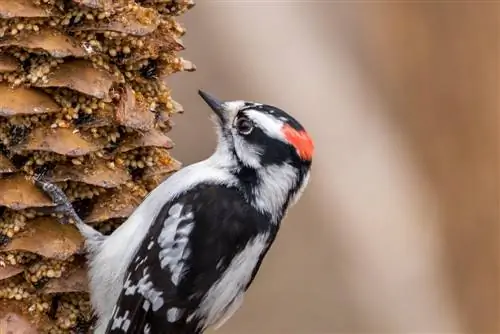
Pine cones can be easily converted into bird feeders
The classic fat ball lacks decorative charm. By making winter bird food yourself with pine cones, you can serve hungry birdies a richly laid table and at the same time beautify the empty garden and balcony. These instructions explain in detail how you can easily make bird food cones yourself:
Material and ingredients
- Cones
- colorful ribbons as hangers
- Felt leaves as decoration
- Hot glue gun and hot glue
- 1 kg fat, ideally beef tallow from the butcher or coconut fat
- 1 tablespoon vegetable oil
- 1 kg grain mixture for wild birds
- optional red rose hips and raisins
- Cooking pot, mixing spoon, teaspoon
Pine cones, which you can collect from the forest floor with your scales wide open, are ideal. Cut ripe, brown pine cones from the branch when they are closed. To open, place pine cones in a dry, airy place where the process can take up to 50 hours. The closed scales open more quickly in the oven with 90° top and bottom heat.
Instructions
- Glue the hanger to the lower end of the tenon, decoratively cover the glue point with a sheet of felt
- Melt the fat in the saucepan (please do not let it boil)
- Remove the kettle from the fire and stir in vegetable oil
- Fold grain food
- Let the food mixture cool until it is spreadable
- Pour the mixture into the spaces between the cones using a teaspoon
- Press rose hips
After a few hours, the bird food cones are hardened and ready to serve as a dangling buffet for hungry bird beaks to feast on.
Excursus
Buy pine cones
Collecting pine cones is not an unadulterated outdoor pleasure when autumn comes with wet, cold weather instead of Indian summer. That's no reason to cross the crafting with pine cones project off your to-do list. You can buy gorgeous, clean pine cones. Recommended and inexpensive shopping sources are local garden centers and tree nurseries as well as online shops from Amazon, Obi, Ebay or specialist suppliers of craft materials. The prices for 100 grams (e.g. 20 large pine cones or 80 larch cones) range between 2.99 and 5.30 euros. The giants among the sugar pine cones (Pinus lambertiana) with an impressive length of 25 cm and a weight of 400 g cost 12 euros.
Growing a tree from pine cone seeds
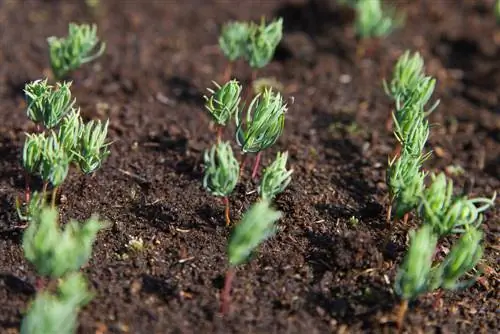
New fir trees can definitely be grown from seeds in cones
Hobby gardeners see pine cones differently than craft and decoration enthusiasts. From their perspective, the green-brown cones are primarily a source of germinable seeds from which a new Christmas tree emerges. Although sowing and growing conifers is a challenge for home gardeners, the masterpiece can be achieved. First, you need to get the pine cones to open so they release their valuable seeds. The following instructions get to the heart of how you proceed:
- best time is in autumn
- Collect pine cones, place them on a plate and open them in the sunny, warm south-facing window
- Harvest seeds, clean them in a fine sieve under running water and clip off the wings
- Soak in water or chamomile tea for 24 hours
- Fill the pot with unfertilized coconut soil
- mix watered seeds with fine sand and sow
- Sift the seeds thinly (0.5 cm) with sand or coconut soil and press down
- pour with a fine spray
- set up in a partially shaded location outside
Direct sowing is possible during the months of October to December, provided the ground is not frozen. A particular advantage of sowing outdoors is the associated natural stratification. Pine cone seeds rely on a cold stimulus to start the germination process. For this reason, it is advisable to place seed containers outdoors, for example on a balcony or terrace.
Care until planting
Ideally, a thick layer of snow serves as a water dispenser. If there is no snow, please water the seeds regularly. Drought stress is the most common cause of high failure rates. Under ideal conditions, you can look forward to the first fir seedlings within 6 to 12 weeks. After successful stratification, bring the cultivation containers into the house, where growth takes its natural course in the partially shaded, warm window seat.
Fir trees take it slow when it comes to height growth. Water the seedlings when it is dry and do not apply any fertilizer at first. Once your pupils have completely rooted the pot, repot the trees. Use coconut soil enriched with liquid conifer fertilizer. In the following three to four years, care consists of watering, fertilizing and repotting. With a growth height of around 15 centimeters, plant the young trees in a partially shaded location with fresh, moist and nutrient-rich soil.
Identifying cone types - distinguishing between pine cones accurately

When there are cones on the forest floor, identifying them becomes a guessing game. Especially if the site is surrounded by different species of coniferous trees, the exact origin is difficult to trace. However, if you know the distinctive properties of cones, you can draw well-founded conclusions as to which tree gave you the treasures. The following table lists important identifying features of six native cone species so that you can accurately distinguish between pine cones in the future:
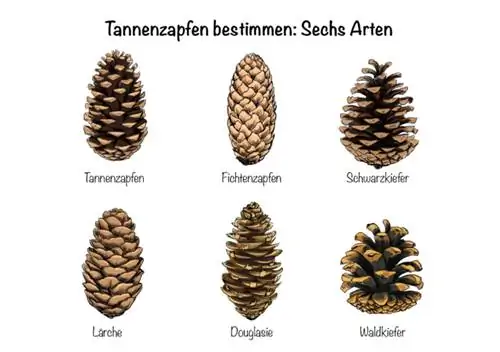
| Pine cones | Spruce cones | Black Pine | Larch | Douglas fir | Scots pine | |
|---|---|---|---|---|---|---|
| Length | 10-16 cm | 10-18 cm | 3, 5-12 cm | 2-6 cm | 2-5 cm | 3-8 cm |
| Width | 3-4 cm | 3-5 cm | 2-4.5cm | 1-2 cm | 2-3 cm | 3-5 cm |
| Colour in autumn | greenish | brown | light brown/yellow brown | light brown | red-brown/brown | dark brown/black |
| hanging/standing/horizontal | standing | hanging | horizontal | standing | hanging | horizontal |
| Feature cone scales | fan-shaped | smooth edges | hidden parts black | wavy scale edges | extended like an awn | protruding far |
| Condition of the forest floor | disintegrate | as a whole | as a whole | as a whole | as a whole | as a whole |
If you find intact cones on the forest floor, they are almost certainly spruce or pine cones. You can only collect large, intact pine cones directly from the tree, where they sit upright on the branches. When pine cones fall from the tree, they are already in the stage of dissolution to clear the way for their winged seeds.
Pine cone jam - recipe for those with a sweet tooth
Do you still have some pine or pine cones left? Then dare to embark on a culinary journey of discovery with pine cone jam. You can conjure up a furious jam from 2 kilograms of cones that will immediately cause a stir in the jar. In addition to the cones of fir, pine or larch trees, the delicious spread also works with the spruce cones that are omnipresent in the forest. The following recipe explains how to do it:
- Wash pine or pine cones
- boil in water for 30 minutes
- let stand in a dark, cold location for over 12 hours
- Take the cones out of the water with a ladle and set aside
- Add 1 kg of sugar to the water and bring to the boil, stirring constantly
The jam stock is ready when it thickens and takes on a purple color. Now take clean one-liter jam jars with screw lids. Place 6 to 8 of the cooked pine cones into each jar. Pour the hot broth over the cones, tighten the screw cap and let the jars cool upside down.
Frequently asked questions
When do pine cones fall from the tree?
Pine cones never fall from the tree in one piece. When the cones of a fir tree are ripe, they open and release the winged seeds into freedom. During this process, pine cones lose their woody scales and fall apart. Only the woody central axis remains on the branch, which only falls off after a few years. For this reason, you can never collect intact pine cones from the forest floor for crafts or decoration. Beautiful, undamaged cones that you discover on the ground in the forest usually come from spruce, pine or larch trees.
What is the difference between pine cones and spruce cones?
The clear difference is the position of the cones on the tree. Pine cones stand upright on the tops of sturdy coniferous branches. Spruce cones hang down from the shoot. Another difference is that pine cones remain on the tree, where they dissolve into their components. Spruce cones fall in one piece to the forest floor in autumn.
Are pine cones suitable as fuel for fireplaces and stoves?
Indeed, you can use pine cones as fuel. Cones from spruce, pine, larch and other conifers can also be used to fuel fireplaces and stoves. Considering the small amount that comes together even through diligent collecting, we recommend using pine cones as natural kindling for free. You can make your own firelighters out of pine cones by wrapping a dry cone with cord as a fuse. Then wrap half of the cone in old newspaper, place it in a muffin tin, pour melted candle wax over it and let everything cool down.
I want to draw pine cones with my elementary school-aged child. Are there any child-friendly templates for this to paint?
Drawing a pine cone freehand is an artistic challenge even for gifted adults. So that your primary school-aged child can paint a beautiful pine cone, there is a varied selection of templates at Gratis-Malvorlagen.de. Etsy and Amazon have reusable stencils on offer for wall decoration or for crafting with pine cones.
We want to collect pine cones that are as large as possible. Which tree has the largest cones for crafting and decorating?
The term pine cone is a synonym for the cones of all conifers. If you collect large pine cones for crafts, look out for spruce and pine trees. Their cones are 16 to 18 cm long and fall to the forest floor as an intact unit suitable for handicrafts. Pine cones, on the other hand, remain on the tree until the bitter end, where they fall apart. The titans in the pine cone kingdom grow up to 40 centimeters long and come from the sugar pine (Pinus lambertiana) from California. You can buy the magnificent specimens online, for example on Amazon or Ebay.
Tip
If you like crafting with pine cones, please do not cut off the entire branch when collecting them. It is gentler on the tree if you pick or snap off ripe cones. As conifers, firs are extremely sensitive to cutting. If you would like to use a coniferous branch and pine cones as decoration, please place the scissors in the green needled shoot area. Under this condition, the fir can fill the gap that has arisen over the years.

